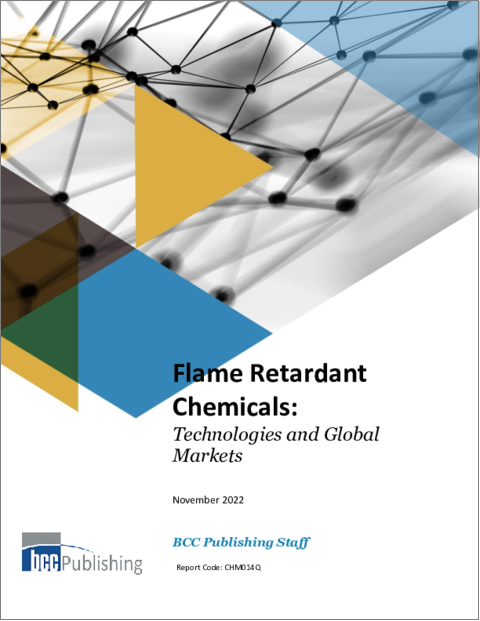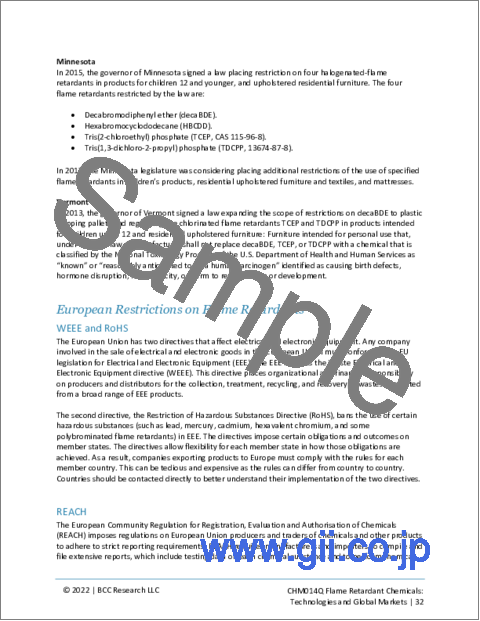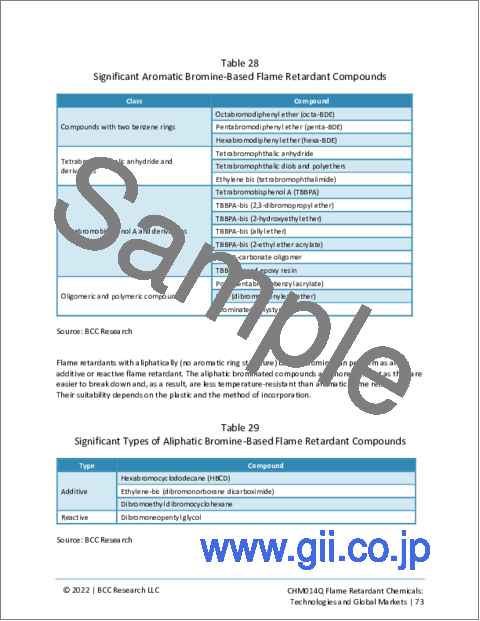|
|
市場調査レポート
商品コード
1141935
難燃剤市場:技術と世界市場Flame Retardant Chemicals: Technologies and Global Markets |
||||||
| 難燃剤市場:技術と世界市場 |
|
出版日: 2022年10月20日
発行: BCC Research
ページ情報: 英文 144 Pages
納期: 即納可能
|
- 全表示
- 概要
- 図表
- 目次
世界の難燃剤の市場規模は、2022年に60億ポンドになるとみられています。
同市場は、2022年~2027年の予測期間中に4.4%のCAGRで拡大し、2027年には75億ポンドに達すると予測されています。
当レポートでは、世界の難燃剤市場について調査し、市場の概要とともに、タイプ別、用途別の動向、特許動向、および市場に参入する企業のプロファイルなどを提供しています。
目次
第1章 イントロダクション
第2章 まとめとハイライト
第3章 市場と技術の背景
第4章 市場動向
- 難燃性材料の分類
- 難燃剤に使用される高分子材料
- 難燃剤市場の特徴
- 難燃剤市場の促進要因と課題
- 促進要因
- 課題
- COVID-19の影響
- ロシア・ウクライナ戦争の影響
第5章 市場内訳、タイプ別
- 難燃性の化学物質
- アルミニウム三水和物
- 酸化アンチモン
- 臭素系化合物
- 塩素系難燃剤コンパウンド
- 水酸化マグネシウム
- メラミン系難燃剤
- リン系難燃剤
- その他
第6章 市場内訳、用途別
- 難燃性製品
- プラスチック
- テキスタイル
- 木/紙
- コーティング/塗料
- 塗装・施工
- 装飾用コーティング
第7章 特許レビュー/新展開
第8章 企業プロファイル
- Top Three Tier-One Companies
- ALBEMARLE CORP.
- ISRAEL CHEMICALS LTD.
- LANXESS AG
- Tier Two Companies
- AKZO NOBEL N.V.
- ARKEMA SA
- BASF
- CLARIANT SPECIALTY CHEMICALS
- DAIHACHI CHEMICAL INDUSTRY CO. LTD.
- DOVER CHEMICAL CORP.
- HUBER ENGINEERED MATERIALS
- IMERYS
- KYOWA CHEMICAL INDUSTRY CO. LTD.
- NYACOL NANO TECHNOLOGIES INC.
- SHERWIN-WILLIAMS CO.
- SOLVAY GROUP
- TOR SPECIALTY MINERALS
- VELSICOL CHEMICAL LLC
- Miscellaneous Flame Retardant Companies
- APEXICAL INC.
- DOW CHEMICAL CO.
- E.I. DUPONT DE NEMOURS AND CO.
- ITALMATCH CHEMICALS SPA
- NABALTEC
- NIHON SEIKO LTD.
- SAKAMOTO YAKUHIN KOGYO CO. LTD.
- SPARTAN FLAME RETARDANTS
- TATEHO CHEMICAL INDUSTRIES CO. LTD.
- Other Organizations
- AZONETWORK UK LTD.
- BUREAU OF ELECTRONIC AND APPLIANCE REPAIR, HOME FURNISHINGS AND THERMAL INSULATION
- CENTERS FOR DISEASE CONTROL AND PREVENTION
- FLAME RETARDANTS-ONLINE
- INTERNATIONAL ORGANIZATION OF FIRE AND RESCUE SERVICES
- JAPAN FIRE RETARDANT ASSOCIATION(JFRA)
List of Tables
- Summary Table : Global Consumption of Flame Retardant Chemicals, Through 2027
- Table 1 : Additives/Modifiers to Control Burning
- Table 2 : Flame Retardants and Generally Accepted Mechanisms of Control
- Table 3 : Additive/Modifiers to Control Burning
- Table 4 : Representative Synergistic Flame Retardant Combinations
- Table 5 : Flame Retardant Chemicals and Their Applications
- Table 6 : Common Classification System for Flame Retardant Chemicals
- Table 7 : Leading Causes of U.S. Residential Fires
- Table 8 : Goals of Simulated Fire Conditions Tests
- Table 9 : Oxygen Indices of Some Common Materials
- Table 10 : Cone Calorimetry Parameters and Values
- Table 11 : UL-94 Burn Test Ratings
- Table 12 : NFPA Guidelines and Standards
- Table 13 : Agencies Involved in Establishing Flame Retardant and Protective Standards
- Table 14 : ASTM Standards Applicable to the Flame Retardant Industry
- Table 15 : Global Market Shares of Major Consumers of Flame Retardant Chemicals, by Application, 2021
- Table 16 : Types of Polymer Materials Used in Flame Retardants
- Table 17 : Flame Retardants Used for Cable Compounds
- Table 18 : Chemicals Generally Used as Flame Retardants
- Table 19 : Significant Flame Retardant Chemicals
- Table 20 : Global Market for Flame Retardant Chemicals, by Chemical Type, Through 2027
- Table 21 : Global Consumption of Aluminum Trihydrate Flame Retardants, Through 2027
- Table 22 : Global Market for Aluminum Trihydrate Flame Retardants, Through 2027
- Table 23 : Global Market for Aluminum Trihydrate Flame Retardant, by End Use, Through 2027
- Table 24 : Global Consumption of Antimony Oxide Fire Retardants, Through 2027
- Table 25 : Global Market for Antimony Oxide Flame Retardants, Through 2027
- Table 26 : Global Market for Antimony Oxide Flame Retardant Chemicals, by End Use, Through 2027
- Table 27 : Types of Aromatic Bromine-Based Flame Retardant Compounds
- Table 28 : Significant Aromatic Bromine-Based Flame Retardant Compounds
- Table 29 : Significant Types of Aliphatic Bromine-Based Flame Retardant Compounds
- Table 30 : Typical Loading of Brominated Flame Retardant Chemicals in Plastics
- Table 31 : Global Consumption of Bromine Fire Retardants, Through 2027
- Table 32 : Global Market for Bromine Flame Retardants, Through 2027
- Table 33 : Global Market for Bromine-Based Flame Retardant Chemicals, by End Use, 2027
- Table 34 : Global Consumption of Chlorine-Based Flame Retardant Chemicals, Through 2027
- Table 35 : Global Market for Chlorine-Based Flame Retardant Chemicals, Through 2027
- Table 36 : Global Market for Chlorine-Based Flame Retardants, by End Use, Through 2027
- Table 37 : Global Consumption of Magnesium Hydroxide Fire Retardants Chemicals, Through 2027
- Table 38 : Global Market for Magnesium Hydroxide Flame Retardant Chemicals, Through 2027
- Table 39 : Global Market for Magnesium Hydroxide Flame Retardant Chemicals, by End Use, Through 2027
- Table 40 : Common Melamine-Based Flame Retardant Chemicals
- Table 41 : Global Consumption of Melamine-Based Flame Retardants, Through 2027
- Table 42 : Global Market for Melamine-Based Flame Retardants, Through 2027
- Table 43 : Global Market for Melamine-Based Flame Retardant Chemicals, by End Use, Through 2027
- Table 44 : Global Consumption of Phosphorus-Based Flame Retardant Chemicals, Through 2027
- Table 45 : Global Market for Phosphorus-Based Fire Retardants, Through 2027
- Table 46 : Global Market for Phosphorus-Based Flame Retardant Chemicals, by End-Use, Through 2027
- Table 47 : Global Consumption of Other Flame Retardant Chemicals, Through 2027
- Table 48 : Global Market for Other Flame Retardant Chemicals, Through 2027
- Table 49 : Global Market for Other Flame Retardant Chemicals, by End Use, Through 2027
- Table 50 : Major Markets Using Flame Retardant Chemicals
- Table 51 : Global Market for Flame Retardant Chemicals, by Application, Through 2027
- Table 52 : Methods of Fabricating Flame Retardant Polymers
- Table 53 : Criteria for Selecting Flame Retardant Chemicals
- Table 54 : Types of Plastic That Use Flame Retardant Chemicals
- Table 55 : Flame Retardants Use in Plastics, 2021
- Table 56 : Global Market for Flame Retardant Chemicals Used in Plastics, by Chemical Type, Through 2027
- Table 57 : Global Market for Flame Retardant Chemicals Used in Textiles, by Chemical Type, Through 2027
- Table 58 : Global Market for Flame Retardant Chemicals Used in Wood/Paper, by Chemical Type, Through 2027
- Table 59 : Global Market for Flame Retardant Chemicals Used in Coatings/Paints, by Chemical Type, Through 2027
- Table 60 : Global Market for Flame Retardant Chemicals Used in Coatings/Construction, by Chemical Type, Through 2027
- Table 61 : Global Market for Flame Retardant Chemicals Used in Coatings for Decorations, by Chemical Type, Through 2027
- Table 62 : List of Applicable U.S. Patents
- Table 63 : Company's Major Flame Retardant Product Lines
- Table 64 : Albemarle Corporation Financial Performance, Through 2021
- Table 65 : ICL Group Financial Performance, Through 2021
- Table 66 : LANXESS's Major Flame Retardant Product Lines
- Table 67 : LANXESS Financial Performance, Through 2021
- Table 68 : Flame Retardant Products of Clariant Specialty Chemicals
- Table 69 : Flame Retardant Products of Dover Chemicals Corporation
- Table 70 : Solvay's Financial Performance, Through 2021
- Table 71 : TOR Specialty Minerals Flame Retardant Product Portfolio
List of Figures
- Summary Figure : Global Consumption of Flame Retardant Chemicals, 2021-2027
- Figure 1 : Global Market Shares of Major Consumers of Flame Retardant Chemicals, by Application, 2021
- Figure 2 : Classification of Flame Retardant Additives Based on Process
- Figure 3 : Classification of Flame Retardant
- Figure 4 : Properties of Flame Retardant Chemicals
- Figure 5 : Drivers and Challenges of Flame Retardant Chemicals Market
- Figure 6 : Fire Accident in India
- Figure 7 : Bio-Based Flame Retardant Chemicals
- Figure 8 : COVID-19 Impact on Construction Industry
- Figure 9 : Impact of Russia-Ukraine War
- Figure 10 : Global Market for Flame Retardant Chemicals, by Chemical Type, 2021-2027
- Figure 11 : Reactions of Antimony Trioxide with Halogens
- Figure 12 : Global Market for Bromine-Based Flame Retardant Chemicals, by End Use, 2021-2027
- Figure 13 : Global Market for Melamine-Based Flame Retardant Chemicals, by End Use, 2021-2027
- Figure 14 : Global Market for Other Flame Retardant Chemicals, by End Use, 2021-2027
- Figure 15 : Global Market for Flame Retardant Chemicals, by Application, 2021-2027
- Figure 16 : Albemarle Corporation Revenue Share, by Business Segment, 2021
- Figure 17 : ICL Group Revenue Share, by Business Segment, 2021
- Figure 18 : LANXESS Revenue Share, by Business Segment, 2021
- Figure 19 : Arkema Inc.- Revenue, 2019-2021
- Figure 20 : Solvay's Revenue Share, by Segment, 2021
Highlights:
The global consumption of flame retardant chemicals is estimated to grow from 6.0 billion pounds in 2022 to 7.5 billion pounds in 2027, at a compound annual growth rate (CAGR) of 4.4% for the period of 2022-2027.
The volume of ATH-based flame retardant chemicals global consumption is&;estimated to grow from 2.0 billion pounds in 2022 to 2.6 billion pounds in 2027, at a CAGR of 5.6% from 2022 to 2027.
The volume of bromine-based flame retardant chemicals global consumption is&;estimated to grow from 1.0 billion pounds in 2022 to 1.3 billion pounds in 2027, at a CAGR of 4.6% from 2022 to 2027.
Report Scope:
This study is an in-depth evaluation of flame retardant chemicals by type and by end-use application between the years 2021 and 2027. This report deals with flame retardant chemical additives, and not with products such as Nafion that are inherently flame retardant.
The forecast will cover worldwide demand and be broken down by chemical type and application. Because electronics are so widely used in the world today and they are housed most often in plastics, this segment will be emphasized.
Report Includes:
- 42 data tables and 29 additional tables
- An up-to-date overview of the global markets for flame retardant chemicals
- Analyses of the global and regional market trends, with historic market revenue for 2021, estimates for 2022, and projections of compound annual growth rates (CAGRs) through 2027
- Estimation of the actual market size and forecast the global flame retardant chemicals market in value and volumetric terms, and their corresponding market share analysis based on product (chemical) type, end-use application, and region
- Identification of the key market drivers and constraints that will shape the industry for these materials as the basis for projecting demand over the next five years (2022-2027)
- Emphasis on the environmental, social, and government regulations and standards, players offering these products and services, and market outlook of flame retardant chemicals within the industry
- Updated information on patents and intellectual property landscape of flame retardant chemicals
- Identification of the major stakeholders and analysis of the competitive landscape based on recent developments and segmental revenues
- Descriptive company profiles of the leading global players, including Israel Chemicals Ltd., Arkema SA, Solvay Group and Apexical Inc.
Table of Contents
Chapter 1 Introduction
- 1.1 Study Goals and Objectives
- 1.2 Reasons for Doing This Study
- 1.3 What's New in This Update
- 1.4 Scope of Report
- 1.5 Information Sources
- 1.6 Methodology
- 1.7 Geographic Breakdown
- 1.8 Analyst's Credentials
- 1.9 Related BCC Research Reports
Chapter 2 Summary and Highlights
Chapter 3 Market and Technology Background
- 3.1 Importance of the Industry
- 3.2 Flame Retardancy Basics
- 3.3 Terminology
- 3.4 Mechanisms of Burning
- 3.5 Flame Retardant Concepts
- 3.5.1 Physical Dilution
- 3.5.2 Chemical Interferences
- 3.5.3 Inert Gas Dilution
- 3.5.4 Thermal Quenching
- 3.5.5 Protective Coatings
- 3.5.6 Generally Accepted Mechanisms of Flame Retardant Control
- 3.6 Types of Flame Retardants
- 3.6.1 Additive Flame Retardants
- 3.6.2 Reactive Flame Retardants
- 3.6.3 Synergistic Flame Retardants
- 3.7 Diversity of Flame Retarded Products
- 3.8 Combined Classification System for Flame Retardant Chemicals
- 3.9 Testing
- 3.9.1 Testing Goals
- 3.9.2 Types of Testing
- 3.10 Industry Environment
- 3.11 The Negative View of Flame Retardant Chemicals
- 3.12 U.S. Regulations Restricting Use of Certain Flame Retardants
- 3.12.1 EPA Guidelines
- 3.12.2 Toxic Substances Control Act (TSCA)
- 3.12.3 U.S. Laws
- 3.12.4 State Laws
- 3.13 European Restrictions on Flame Retardants
- 3.13.1 WEEE and RoHS
- 3.13.2 REACH
- 3.13.3 POPs
- 3.14 Worldwide Regulations on the Use of Flame Retardants
- 3.14.1 Asian Regulations
- 3.15 Significant Organizations Regulating Fire Control
- 3.15.1 National Institute of Standards and Technology (NIST)
- 3.15.2 International Code Council (ICC) and the International Building Code (IBC)
- 3.15.3 U.S. Federal Aviation Regulations
- 3.15.4 Upholstery Regulation
- 3.15.5 National Institute for Occupational Safety and Health (NIOSH)
- 3.15.6 Occupational Safety and Health Administration (OSHA)
- 3.15.7 Role of Non-Federal Agencies
- 3.15.8 Other Organizations of Interest
- 3.16 Major Consumer Industries
- 3.17 Major Producers of Flame Retardant Chemicals
Chapter 4 Market Trends
- 4.1 Classification of Flame Retardant Materials
- 4.2 Polymer Materials Used in Flame Retardant
- 4.3 Properties of Flame Retardant Chemical Market
- 4.4 Drivers and Challenges of Flame Retardant Chemical Market
- 4.5 Drivers
- 4.6 Challenges
- 4.7 COVID-19 Impact
- 4.8 Russia-Ukraine War Impact
Chapter 5 Market Breakdown by Type of Flame Retardant Chemical
- 5.1 Chemicals That Are Flame Retardant
- 5.2 Aluminum Trihydrate
- 5.2.1 Bauxite/Aluminum Trihydrate Sources
- 5.2.2 Aluminum Trihydrate Grades
- 5.2.3 Market for Aluminum Trihydrate Flame Retardants
- 5.3 Antimony Oxide
- 5.3.1 Sources of Antimony Oxide
- 5.4 Bromine-Based Compounds
- 5.4.1 Types of Bromine-Based Flame Retardants
- 5.4.2 Market for Bromine-Based Flame Retardants
- 5.5 Chlorine-Based Flame Retardant Compounds
- 5.5.1 Chlorine-Based Flame Retardant Properties
- 5.5.2 Sources of Chlorine
- 5.5.3 Chlorine-Based Flame Retardant Types
- 5.5.4 Dechlorane Plus
- 5.5.5 Market for Chlorine-Based Flame Retardants
- 5.6 Magnesium Hydroxide
- 5.6.1 Magnesium Hydroxide Properties
- 5.6.2 Sources of Magnesium Hydroxide
- 5.6.3 Magnesium Hydroxide Grades
- 5.6.4 Magnesium Hydroxide as a Flame Retardant Market
- 5.7 Melamine-Based Flame Retardants
- 5.7.1 Melamine Homologues
- 5.7.2 Market for Melamine Fire Retardants
- 5.8 Phosphorus-Based Flame Retardants
- 5.8.1 Phosphates
- 5.8.2 Phosphonates and Phosphinates
- 5.8.3 Red Phosphorus
- 5.8.4 Ammonium Polyphosphate
- 5.8.5 Market for Phosphorus-Based Flame Retardants
- 5.9 Other Flame Retardants
- 5.9.1 Boron-Based Fire Retardants
- 5.9.2 Molybdenum-Based Fire Retardants
- 5.9.3 Nanocomposite Flame Retardant Chemicals
- 5.9.4 In Situ Polymerization
- 5.9.5 Graphite-Based Flame Retardant Chemicals
- 5.9.6 Dust-Free Sustainable Polymeric Flame Retardant Systems
- 5.9.7 Market for Other Flame Retardant Chemicals
Chapter 6 Market Breakdown by Application
- 6.1 Products That Are Smoke and Flame Retarded
- 6.2 Plastics
- 6.2.1 Flame Retardant Methods Used for Plastics
- 6.2.2 Flame Retardants Used in Plastics
- 6.2.3 Forecast for Flame Retardant Chemicals in Plastics
- 6.3 Textiles
- 6.3.1 Textile Classifications
- 6.3.2 Types of Textiles
- 6.3.3 Flame Retardant Chemicals Used in Textiles Global Market
- 6.4 Wood/Paper
- 6.4.1 Global Market for Flame Retardant Chemicals in Wood/Paper
- 6.5 Coatings/Paints
- 6.5.1 Flame Retardant Chemicals in Coatings/Paints Market
- 6.6 Coatings/Construction
- 6.6.1 Global Market for Flame Retardant Chemicals in Coatings/Construction
- 6.7 Coatings for Decorations
- 6.7.1 Flame Retardant Chemicals in Coatings for Decorations Market
Chapter 7 Patent Review/ New Developments
- 7.1 Patent Activity
- 7.2 Other Recent Developments
- 7.2.1 BASF and THOR GmBh
- 7.2.2 LG Chem FR Plastics
- 7.2.3 Imerys ImerShield
- 7.2.4 Samyang T-FR PC
- 7.2.5 Huber Acquire Magnifin
- 7.2.6 Dow PolyFR
- 7.2.7 LANXESS
- 7.2.8 Albemarle
- 7.2.9 ICL
- 7.2.10 BASF
- 7.2.11 Fire Retardant Gels
- 7.2.12 Carbon Nanotubes (CNTs)
- 7.2.13 Nanocoating Comprised of Positively Charged Chitosan (CH) and Anionic Poly (Vinyl Sulfonic Acid Sodium Salt)
- 7.2.14 Clay, Crab Shells, and DNA-Based "Green" Fire Retardants
- 7.2.15 Bio-inspired Coatings on Flexible Polyurethane Foam
- 7.2.16 Ocean Bacteria Produce Flame Retardants
- 7.2.17 BASF Ultramid A3U42G6 Halogen-Free Flame Retardant
- 7.2.18 Sony Launches Outside Sales of SORPLAS Flame Retardant Recycled Plastic Material
- 7.2.19 Researchers Create Dairy-Based Flame Retardant
- 7.2.20 U.S. Navy's Introduction of Flame Retardant Uniforms
- 7.2.21 Nontoxic Synthetic Polydopamine Fire Retardant
- 7.2.22 Graphene Fire Retardant
- 7.2.23 New Fire-Resistant Coating to Prevent Failure in Steel Building Fires
Chapter 8 Company Profiles
- 8.1 Top Three Tier-One Companies
- ALBEMARLE CORP.
- ISRAEL CHEMICALS LTD.
- LANXESS AG
- Tier Two Companies
- AKZO NOBEL N.V.
- ARKEMA SA
- BASF
- CLARIANT SPECIALTY CHEMICALS
- DAIHACHI CHEMICAL INDUSTRY CO. LTD.
- DOVER CHEMICAL CORP.
- HUBER ENGINEERED MATERIALS
- IMERYS
- KYOWA CHEMICAL INDUSTRY CO. LTD.
- NYACOL NANO TECHNOLOGIES INC.
- SHERWIN-WILLIAMS CO.
- SOLVAY GROUP
- TOR SPECIALTY MINERALS
- VELSICOL CHEMICAL LLC
- Miscellaneous Flame Retardant Companies
- APEXICAL INC.
- DOW CHEMICAL CO.
- E.I. DUPONT DE NEMOURS AND CO.
- ITALMATCH CHEMICALS SPA
- NABALTEC
- NIHON SEIKO LTD.
- SAKAMOTO YAKUHIN KOGYO CO. LTD.
- SPARTAN FLAME RETARDANTS
- TATEHO CHEMICAL INDUSTRIES CO. LTD.
- Other Organizations
- AZONETWORK UK LTD.
- BUREAU OF ELECTRONIC AND APPLIANCE REPAIR, HOME FURNISHINGS AND THERMAL INSULATION
- CENTERS FOR DISEASE CONTROL AND PREVENTION
- FLAME RETARDANTS-ONLINE
- INTERNATIONAL ORGANIZATION OF FIRE AND RESCUE SERVICES
- JAPAN FIRE RETARDANT ASSOCIATION (JFRA)




